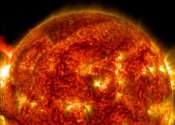First clues to the start of Earth's supercontinent cycle found
Curtin University research has uncovered the first solid clues about the very beginning of the supercontinent cycle of Earth, finding it was kick-started two billion years ago.

Curtin University research has uncovered the first solid clues about the very beginning of the supercontinent cycle of Earth, finding it was kick-started two billion years ago.
Earth Sciences
Mar 24, 2021
0
49

Astronomers from the ARC Centre of Excellence for Gravitational Wave Discovery (OzGrav) and CSIRO have just observed bizarre, never-seen-before behavior from a radio-loud magnetar—a rare type of neutron star and one of ...
Astronomy
Feb 1, 2021
76
1370

Using information from ESA's Swarm satellite constellation, scientists have made a discovery about how energy generated by electrically-charged particles in the solar wind flows into Earth's atmosphere—surprisingly, more ...
Space Exploration
Jan 12, 2021
0
742

Solar flares—violent explosions on the surface of the sun—can send blasts of radiation hurtling toward Earth. While the planet's magnetic field protects humans on the surface, powerful solar flares can disable satellites, ...
Space Exploration
Jul 31, 2020
135
326

A new ultra-bright source of X-rays has awakened in between our galactic neighbors the Magellanic Clouds, after a 26-year slumber. This is the second-closest such object known to date, with a brightness greater than a million ...
Astronomy
Jun 3, 2020
1
470

In an area stretching from Africa to South America, Earth's magnetic field is gradually weakening. This strange behaviour has geophysicists puzzled and is causing technical disturbances in satellites orbiting Earth. Scientists ...
Space Exploration
May 20, 2020
12
9815

The team of researchers that maintain the World Magnetic Model (WMM) has updated it and released it a year ahead of schedule due to the speed with which the pole is moving. The newly updated model shows the magnetic north ...

Our team at IBM Research made a breakthrough in controlling the quantum behavior of individual atoms, demonstrating a versatile new building block for quantum computation.
Quantum Physics
Oct 25, 2019
0
64

Mercury's ancient magnetic poles were far from the location of its poles today, implying its magnetic field, like Earth's, changed over time, a new study says.
Space Exploration
Sep 4, 2019
0
697

Cutting a magnet in half yields two magnets, each with its own north and south pole. This apparent absence of an isolated magnetic pole, or "magnetic monopole," has puzzled physicists for more than a century. It would seem ...
General Physics
Jun 12, 2019
0
249